
Motorola announced yesterday the super-thin and extra-durable Droid Razr smartphone. Armed with Android 2.3.5 Gingerbread, a dual-core 1.2GHz processor, a 4.3-inch super AMOLED display, and solid maximum battery life, the device has the potential to be one of the most popular handsets available on Verizon Wireless. But no phone can go without standing against Apple’s new iPhone 4S, which has already broken sales records less than a week after it officially went on sale. So, how does Motorola’s latest offering compare to Apple’s? Let’s break it down in this spec showdown.
| Droid Razr | iPhone 4S | |
| Carrier | Verizon | Verizon/AT&T/Sprint |
| Connectivity | CDMA dual-band/4G LTE | GSM/CDMA (3G HSPA) |
| Thickness | 7.1mm | 9.3mm |
| Weight | 127g | 140g |
| Display size | 4.3-inches | 3.5-inches |
| Display resolution |
960×540 | 960×640 |
| OS | Android 2.3.5 | iOS 5 |
| Processor | dual-core 1.2GHz | dual-core 800MHz A5 |
| RAM | 1GB | 512MB |
| Internal storage | 16GB | 16GB/32GB/64GB |
| MicroSD |
Yes (16GB included) | No |
| Rear camera | 8MP | 8MP |
| Front camera |
1.3MP | VGA |
| Video recording | 1080p | 1080p |
| Wi-Fi | Yes | Yes |
| GPS | Yes | Yes |
| Bluetooth | Yes | Yes |
| HDMI | Yes | No |
| Battery life (talk) | 12.5 hours | 8 hours |
| Battery life (video) | 8.9 hours | 10 hours |
| Price (w/2-yr contract) |
$299 | $199/$299/$399 |
Correction: An earlier version of this chart incorrectly said the Droid Razr does not have an HDMI port. It has been corrected. (Thanks, James!)
Editors' Recommendations
- An Apple insider just revealed how iOS 18’s AI features will work
- 5 phones you should buy instead of the iPhone 15
- iPhone 16: news, rumored price, release date, and more
- iPhone SE 4: news, rumored price, release date, and more
- 3 reasons why I’ll actually use Anker’s new iPhone power bank


